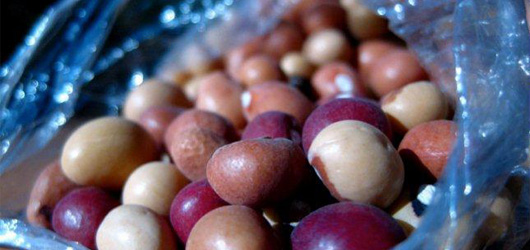
Bambara groundnut (Vigna subterranea (L.) Verdc.) is variously known as izindlubu (Zulu, South Africa); Jugo beans (South Africa); Ntoyo cibemba (Zambia); Gurjiya or Kwaruru (Hausa, Nigeria); Okpa (Igbo, Nigeria); Epa- Roro (Yoruba, Nigeria); Nyimo beans (Zimbabwe); etc.
Description
Bambara groundnut is a grain legume grown mainly by subsistence farmers in sub-Saharan Africa. It is cultivated for its subterranean pods, is extremely hardy and produces reasonable yields even under conditions of drought and low soil fertility. The pods are approximately 1.5 cm long, and may be wrinkled and slightly oval or round, containing one to two seeds. The colour of the seeds varies from black, dark-brown, red, white, cream or a combination of these colours. At harvest, i.e. when the pods ripen, the plant is extracted from the soil, exposing the subterranean nuts.
The nuts may be eaten fresh (i.e. boiled or roasted before they are dried) as snacks but the majority of the nuts are consumed after they are dried. The dried nuts, with very hard seed coats, are milled and sieved to yield very fine flour that is used to prepare a variety of dishes including dumplings, cakes and biscuits.
Where it is found
Bambara groundnut is indigenous to sub-Saharan Africa where it is widely cultivated. The centre of origin is most likely North-Eastern Nigeria and Northern Cameroon, in West Africa. The species is also grown to a lesser extent in some Asian countries such as India, Malaysia, Philippines and Thailand.
How to eat it
Dumplings
Ingredients: 500 grams Bambara nut flour, 50ml palm oil, 2 stock cubes (crushed), 1 small onion (chopped fine), ground chilli pepper (to taste), salt (to taste) and warm water (as needed). Container: bowls, aluminium foil bags or plantain leaves.
Preparation: Pour the flour into a bowl, add the palm oil and mix thoroughly, until the flour changes from white to orange or yellow. Add the warm water and mix thoroughly, making sure the mixture is not too watery and is without lumps. Add the stock cubes, onions, chilli pepper and salt to taste. Mix thoroughly. Pour the mixture into a container and place in a pot of boiling water. Boil for 45-60 minutes, adding water if too dry. Leave to cool and then serve.
Special qualities
known as a “complete food” as the seeds contain on average 63% carbohydrate, 19% protein and 6.5% fat, making it a very important source of dietary protein.
Importance for smallscale farmers
extremely tolerant of poor quality soils and drought, as well as its ability to yield a crop in conditions in which peanut fails;
particularly suitable for the low-input agricultural production systems in the drought-prone regions where it is grown;
its nitrogen-fixing roots, which help replenish soil nutrients, make it suitable in intercropping systems with maize, millet, sorghum, cassava, yam, etc.;
the leaves are rich in nitrogen and potassium and therefore an excellent source of animal feed.
Link:
Nenhum comentário:
Postar um comentário